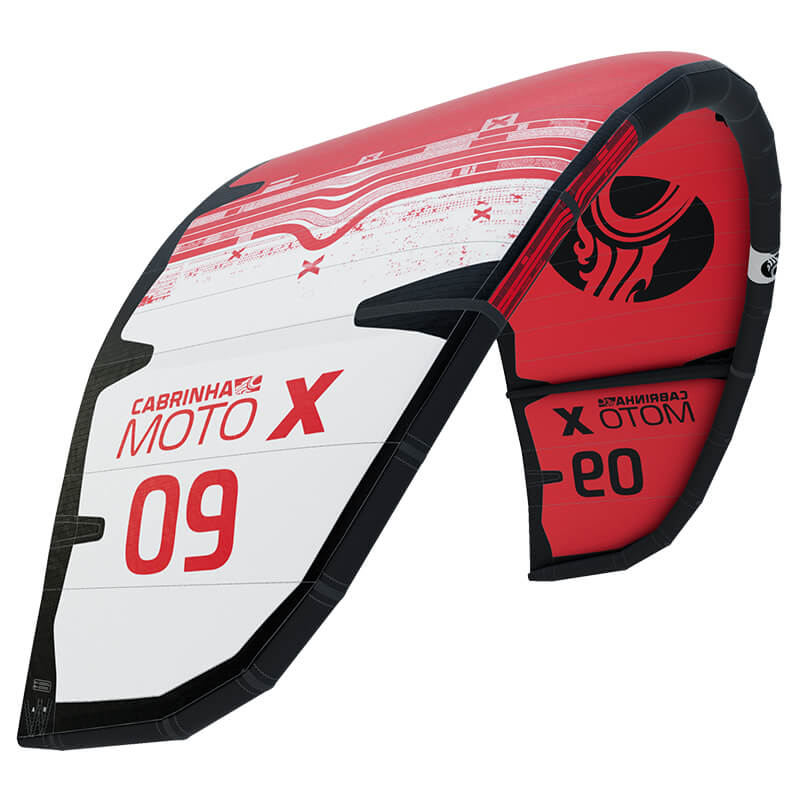When you purchase gear through links on our site, we may earn a small commission. Here’s why you can trust our tests and our affiliate partner.

The Moto has always been a firm freeride favorite in the Cabrinha range, and this year it sees its biggest refresh to the popular product line in some time. Gone is the open C shape with wide tips, and we’re presented with a far more performance hybrid shape with way more sweep to the much leaner and efficient looking airframe, bringing it more in line with its European-designed performance freeride counterparts. If it’s possible for a kite to look all the more ‘sporty’ than its predecessor it’s pulling this off a treat.
Pat Goodman has been busy, to say the least, and from a materials perspective there’s been a multitude of changes, most significant of which is the HTD Lite Dacron frame. This is implemented to make the kite stiffer, lighter and far more reactive to bar inputs. The bridle system has also been completely redesigned and is pulley-less, adding to the crisp and eager turning characteristics. Further weight savings have been gained by lightening up the bladder materials and striking a decent balance between durability and overall kite weight. The Pure Profile panels that make up the canopy now run bidirectionally, cleaning up the profile further than previously, improving efficiency and controlling deformation through the Nano-coated ripstop. The trailing edge is a two-ply affair with lightweight EVA battens implemented to control flutter in between the three struts; the leading edge sees some lightweight TPU bumpers. Inflation is handled by an all-new proprietary system they’ve coined the Sprint 3.0, where the single point inflation valves from strut to leading edge are threaded and the tube retainers screw on. The isolation clips all have neat Cabrinha stamped covers. Inflation is handled by a bayonet style valve which is removable and easy to service and replaced if necessary. The fixtures and fittings all look and feel extremely bespoke, premium and well thought out, without a zip tie in sight.
In the air, it’s as if the old Moto has been given a few double espressos. It’s faster in all aspects with considerably lighter bar pressure. Turning speed and its general eagerness to initiate a turn is completely different to previously. There’s a level of directness and lively handling we’ve not really experienced from a previous Moto, which was historically a more smooth and cruisy side. Chucking a loop produced a smooth pulse of power, and it’s quick enough to bring the kite quite low and expect a decent degree of catch. Sheeting inputs across the bar throw feel very linear, with an impressively high level of control with your arms extended; the back lines never seem to go slack. In a wave scenario, this new-found mobility and high levels of depower available shine well, and the aforementioned level of reactivity whilst depowered allows the kite to shoot across the window whilst you bottom turn. The swept shape makes the new Moto extremely fast to relaunch, which in a wave environment is ever the more important feature.
The lighter frame of the kite of course enhances its low end, transferring well into the realms of freeride foil use, which is particularly entertaining on the shorter line option. There’s enough stability, playfulness and bar feedback to whip you through your maneuvers with confidence. This new, more reactive nature will definitely please the freeriding multi-discipline rider, and whilst the Moto is trimmable on the back lines to tone this down for those more unhooked freestyle focused riders, the much more park-and-pop focused FX2 is a better bet, particularly in the smaller sizes.
It’s a complete sea change for the Moto X, and this lively, fresh and most importantly fun feeling kite is perhaps heralding a brave new era from the long-established Hawaiian brand. It’s a kite anyone can jump on and achieve plenty with across disciplines, and is a true modern benchmark of versatility.
